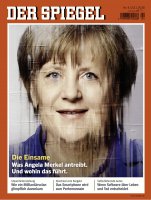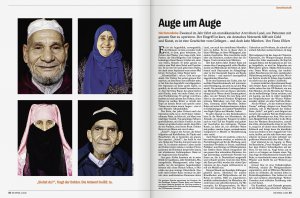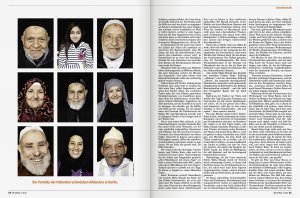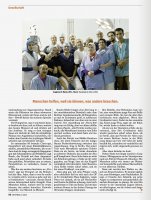"Der Spiegel" 04/2016
04 Jan



An Eye for an Eye
Out of compassion
Twice a year, a Moroccan physician travels across the countryside to perform surgeries on patients with cataracts. The procedure takes place in a very short time, a German network helps with money and art, it is a success story – but not a fairy tale.
By Fiona Ehlers / DER SPIEGEL
===
It is an unforgettable moment, there is light again. The doctor gently pulls the bandage from the eye of his patient, Omar Banni, an 81-year-old sheepskin tanner and part-time singer. Banni blinks his eyes. He is just coming back to a world without haziness and blur. Like babies born deaf and hearing for the first time after getting an implant: They laugh. Omar Banni laughs too. ‘Alhamdulillah,’ he cries, thank god. The doctor has cured his cataract which almost caused him to go blind. He gave him back his eyesight. Usually the surgery is not a big deal, not even very expensive, but for Omar Banni, the old tanner, father of eight and grandfather of even more, it is a miracle. In shock he jumps up from his bed, hugs the doctor, a giant in a lab coat, and presses his head to his chest with tears in his new eyes. Alhamdulillah.
The first thing every patient sees after this surgery is him, the doctor: Abderrahmane Raiss, a handsome, fifty-year-old man, with hands like paws and the wide-chested build of a heavy-weight boxer with a gentle smile on his face. Dr. Raiss is a man with two lives. ‘Schuf?’ he asks the poor, the tanners and basket makers, the potters and construction workers whose cataracts he cures free of charge. ‘Schuf ?’ means something like ‘Do you see?’ And the answer he always gets is: yes. In his other life, the doctor earns his money by lasering the corneas of well-off private patients with ultrashort light pulses. Dr. Raiss is a luminary oculist. People from all over Africa come to his clinic in Casablanca, which has a staff of ten employees and is replete with precious marble flooring, flower bouquets, and massage chairs. Not everyone can afford to be treated by him, as there is only a very thin upper crust in Morocco. This is why Dr. Raiss travels across the country twice a year with his medical caravan in order to help people who would not be able to afford a treatment. What is about to come is a story about success, not a fairy tale, and quite different from what one is used to hearing about, especially in regards to the current state of the world. With his camping trailer stuffed with medicine and microscopes, Dr. Raiss travels along the coast, drives up to Ouarzazate in the Atlas Mountains or to Zagora, a city at an oasis in the Sahara desert, and treats people with ophthalmic diseases.
One could call it a caravan of light, or a mobile unit with global reach if you will, setting out on their mission. At the wheel is a retired French truck driver from Montpellier, who for decades carried all kinds of products ranging from tomatoes to coffins across Europe. Now he transports a very heavy Carl Zeiss microscope from Jena, Germany, through Morocco. Dr. Raiss and a team of nurses follow him in their off-road vehicle carrying plastic lenses manufactured by Eagle Optics in Mumbai, India. Today, they set out to meet with artisans in the Medina of Marrakesh, accompanied by a photographer from Germany. He is going to collaborate on this project, and become a part of this success story. Thomas Rusch, 53 years old, a delicate man with big, round eyes, normally takes pictures of models wearing the newest fashion or even nothing at all.
Like Dr. Raiss, Rusch also has another life beside this one. He works as a portrait photographer for advertising, staging products, and sometimes politicians. Rusch’s contribution to Dr. Raiss’s mission for the blind is taking pictures of the cataract patients. He produces intricate and touching portraits of them, which will then be shown in galleries – and sold. The revenue, 460 euros per portrait, helps to finance the surgeries. This practice is supposed to become a model for other organizations and charities.
The photographer and other foundations involved in this project hope to inspire the start of similar organizations addressing other diseases and problems, offering fast, accessible help for people who cannot read or write, for victims of landmines, for the disabled, for people with cleft palates. The list of diseases and other problems that could be solved with simple means is long.
The dancer’s eye is wide open. A clamp that resembles an eyelash curler pulls her lids apart. For lack of a proper headrest, her head is fixed to the operating table with masking tape. What is about to come will be a matter of micrometers. Malika Benchouchou, a woman of about sixty, and a professional belly dancer, feels nothing. Her left eye has been anaesthetized with a syringe. The only thing she can feel is the glaring light beam. Dr. Raiss leans over her in a rudimentary operating room, to his right are his surgical instruments, a mobile display screening the dancer’s heartbeats, and a laptop playing the New Year’s Concert by the Vienna Philharmonic from YouTube on full blast. As the orchestra is just about to start ‘The Blue Danube’ conducted by Barenboim – in Marrakesh, Dr. Raiss shouts an encouraging ‘Jalla!’, let’s start, and sets his naked foot on the pedal of the big microscope from Jena – his way of conducting. He quickly cuts three tiny holes into Ms Bencouchou’s cornea, parts the cloudy, degenerated lens in four, sucks it off with a small tube, and positions the new artificial lens from India inside the dancer’s eye. The new lens is completely transparent, costs around 10 Euros, and is hardly visible even when magnified tenfold as on the screen above Raiss’s head. While Barenboim’s orchestra wishes a ‘Happy New Year” from the laptop, pearls of sweat show on Dr. Raiss’s forehead. It was his fourteenth eye today, he will have operated twenty-five by the end of the day.
The belly dancer’s eye needs rest now. It vanishes under a big, soft patch and will stay closed for a while. Eye cataracts are a widespread disease. The World Health Organisation estimates that approximately 20 million people lost sight because of it, predominantly in the developing world. The disease is congenital and mostly age-related. Other causes are malnutrition and too much sun.
The illness is recognizable with the naked eye: light grey flow- marks, which cloud the lens behind the pupil. The afflicted person perceives the world as through a dirty window and often notices the impaired vision too late, because of illiteracy. Without an operation, the cataract will lead to a complete loss of eyesight – and with it often the loss of a job, and the ability to support a family. Stories like these are much too common in the poorer parts of the world. In Germany for example, where mostly older people suffer from cataracts, the ambulant surgery is a routine operation in which the old lens is replaced with a new artificial one in less than ten minutes. It is one of the most frequently performed surgeries and the costs are covered by health insurance.
In other parts of the world this looks somewhat different. Approximately 40 million people worldwide are blind, with someone losing his eye-sight every few seconds.. Every second one of them goes blind due to cataracts, and a timely surgery would have helped them avoid this fate.
The aim of Dr. Raiss is to contribute to solving these problems, which is why he leaves his wife, an oculist herself, and his three children alone. His elegant practice near Casablanca’s palm-lined Corniche then has to function without him. There are 90,000 cataract patients in Morocco each year, of which about half get the surgery, but Raiss is the only one taking his equipment and staff and going directly into the poor areas of Rabat, Fez and Marrakesh and to the remote villages in the mountains or the desert.
The first time he came to Zagora, a thousand Berbers, many of them nomads, waited in line in front of his operating tent to get surgery. There was not enough time to help them all. Experiencing this misery so closely convinced him to return and help until everyone was cured.
Dr. Raiss says his work has made him more humble, but also much more happy. At the same time, his activity had turned him more pragmatic. ‘Two Moroccans with one eye,’ he explains to patients, ‘see more than one Moroccan with two eyes,’ which is why he only performs surgery on one eye at a time. That way, he is able to help more patients overall.
When Dr. Raiss’s caravan reaches Marrakesh, Maha Elmadi joins the team. She became acquainted with the physician when he lasered her eyes. The self-confident 44 year-old woman with the fluttering djellaba is well known in the Medina of Marrakesh. With its mosques, bazaars and the famous Jemaa el-Fnaa, the square of the jugglers, the Medina is the center of the old imperial city. Elmadi was born in an area of the Medina that has not been turned into an oriental theme-park, as large parts of the Medina are now. Here, skilled artisans sit in their booths along the narrow streets and per- form traditional crafts. In order to maintain these traditions, Maha Elmadi – a proud and beautiful woman married to an officer of the king’s mother’s life guard – runs a traditional workshop-space named the Stork’s House, which now houses the Dar Bellarj social center and training school. When she began her visits to the old artisans in the Medina, she was the first to recognize the grey clouds in the eyes of tailors, weavers, silversmiths. Maha Elmadi introduced Mr. Raiss’s ‘Albassar’ project to the German ‘Abury’ Foundation, which on the one hand supports Moroccan artisans and on the other sells Berber handbags in a trendy street in Berlin -and who soon brought photographer Rusch into play.
Upon arriving in the Medina, Dr. Raiss examined potential patients for three days. Those with cataracts were given a stamp into their patient’s records: ‘On doit opérer,’ must have surgery. A few months later, Raiss came back with a team and equipment, and performed the surgeries in the old hospital next to the Dar Bellarj. He would heal sixty craftsmen and women in three days. Maha Elmadi took care of the patients, held their hands or dried their tears. She knew everyone of them personally and tried to soothe their anxiety. In this way, she became another crucial part of this success story about people putting so much time, strength, and talent into creating and sustaining community and companionship. Where one performs urgent surgeries, the other makes pictures in order to communicate to the world, and another organizes and manages resources.
In the afternoon with the medical crew still at work, Maha Elmadi shows us around the neighborhood, through dark alleyways, passing a hat maker whose cataracts had been treated only a short while ago, sitting under an umbrella, braiding straw as if nothing had happened.
At the bazaar the spice traders shovel cinnamon, cardamom and cumin on top of appetizing pyramids, and in the cafés the waiters elegantly pour mint tea from silver pots into tiny glasses. Maha Elmadi has known all of this since she was a child, but while taking a walk through the Medina last year, she suddenly became aware of its decay and artificiality. The new, shiny Marrakesh is effacing the old, real, and ancient world of the Medina. Tourists from affluent Arab countries show off their wealth, and the party people from Europe, descendants of the hippies that had visited Marrakesh in the 1970’s, come dangerously close to the old city center. With them come the wellness temples for Westerners, shopping centers, stretch limousines, the clicking of cameras, the rolling of carry-on luggage. The Medina has become a popular destination on global tourist trails, and one wonders what is more authentic: the humanities student dressed up as a snake charmer, or the mountains of cheap products made in China this same student is bargaining over. Tourists replace residents, Airbnb users replace established communities, and sooner or later the artisans will no longer be able to find new apprentices to whom they can teach their crafts. Maha Elmadi calls this phenomenon ‘morale cataracte’, and says that she and Dr. Raiss want to do something about it.
Maha turns into the old quarter of the tanneries, where Omar Banni has his work place, the patient whose bandage Raiss had removed just this morning. Men stand up to their knees in pools of dye – blue, yellow, red – in which the sheep skin is tanned and then tinted. Every day for sixty years he stood here too, his naked feet bathed in multiple acids. Now, his son works in the tanneries as well. Unlike his father in his time he wears rubber boots, but the smell still is hardly bearable, and the old man regularly passes by shouting instructions on how to dye the babouches, the belts, the sofa cushions. Banni lives not far from here, in a house stuffed with souvenirs from when he was on the road with his then well-known band playing traditional music. He himself sang and played the oud, a Persian pear-shaped lute. His voice is still strong, and, thanks to Dr. Raiss, his eyes are now clear again. He can see his wife again, the woman to whom he has been married for 62 years now, a Moroccan with broad hips and an even bigger smile, who he still calls ‘ma gazelle.’ Hung on a living room wall in Berlin’s elegant Charlottenburg district, is a photo of Omar Banni. It shows a man wearing an embroidered prayer cap. He has full lips, sun-tanned skin and a dark spot on his forehead caused by touching the floor while praying in the mosque. The photo captures an intimate moment, the hint of a smile. It is one of the most beautiful portraits from the Moroccan series by Thomas Rusch. The photo session took place in Maha Elmadi’s Stork’s House on the day of his examination prior to the surgery. Rusch sat the patients in front of a black background, an exchange between the photographer and his subjects ensued – though neither understood the other’s language.
The photographer did what he does best. He got his models to trust him, to open up. He waited patiently for the best moment and then pressed the shutter button. This was how he won the smile of the chaste imam, got a raised eyebrow from the ten year old Hazim, coaxed the whimsical smile out of the fifty-year-old metal-worker. These photo-sessions yielded 88 close-ups, taken with a small for- mat camera. Rusch says these beautiful and touching moments were very different from the arranged meetings with actors and politi- cians that make up his other work. Dr. Raiss’s project had changed his life, too. It made him set new priorities, change his perception of the world – caused him to ‘see better.’
The photographer says that it is the simplicity that fascinates him the most about ‘PortrAid’. Everyone to whom he talks about it immediately understands what it is about and how it works. This is why Rusch spends his annual vacation on the project; and why people help – simply because they are able to offer something that others are in need for. It is a very direct form of development aid, from person to person.
For a while, Rusch’s photos were on show in the Moroccan Em- bassy in the historic center of Berlin: 82 pictures, 40 by 60 centi- meters, framed in black, lit from above, like at an art gallery. The exhibition turned out to be a huge success, most of all because it ful- filled its goal of selling enough pictures so that all the patients on Dr. Raiss’s list could have their surgeries paid for with money raised through the exhibition.
Malika Benchouchou’s portrait was among the ones on display in the exhibition, the old belly dancer with the indigo-blue Berber tattoo between her eyebrows. During his most recent tour to Marrakesh she was Dr. Raiss’s last patient, because she also has diabetes, which made the surgical intervention a bit more complicated. She deliberately did not tell her son about her plans, she assumed that he would not have permitted the operation out of concern that she might not survive the procedure. But Benchouchou wanted to be able to see clearly again, and she has always been stubborn.
The surgery was a success and, full of relief, though with a ban- dage over her eye, she let herself be accompanied back to her skewed house, where she shows photos of her past, when she was still young and swinging her hips at weddings in high-necked dresses made of taffeta and silk, and singing with the other women at the party in high, oscillating voices. Her granddaughter who works as a midwife comes by. She is a veiled young woman with glasses and a serious look on her face. She has always objected to the traditional Berberian lifestyle and finds her grandmother’s dancing obscene. No young woman, she says, would want to live like that today. When she heard about Benchouchou’s surgery and understood that her grandmother would soon be able to see clearly again, and that her portrait now adorns the living room of a Berlin author and how much money he had spent on it, she snorted contemptuously, annoyed about not having been told in advance, but then, after a moment of consideration, her face broke into a genuinely happy smile.
By this time, Dr. Raiss is already back in Casablanca, ha- ving his lunch break by the Corniche near the Hassan II-mosque. As usual, the seaside is crowded with people wearing sunglasses and enjoying fresh seafood served on silver plates. Dr. Raiss watches the waves breaking by the beach. He comes here every day, to be silent, to think. He says that he needs the Atlantik Ocean to relax his eyes and mentally plan the next caravan. This one will take him back to the oasis-city Zagora, where everything began, and where his mission is yet to be accomplished.
Captions:
page 52:
„Do you see?“ asks the doctor. The answer is: Yes.
page 53:
The portraits of patients before their cataract surgeries shown here are from the series made by photographer Thomas Rusch from Hamburg, Germany. The photos were sold in Germany to finance the medical caravan.
Page 54:
The portraits of the patients now artfully adorn apartments in Berlin.
Page 56:
Eye specialist Dr. Raiss (center), Team: Caravan of Light.
People help, because they are able to offer something that others are in need of.
From “DER SPIEGEL” No.4 2016 (23.01.2016)